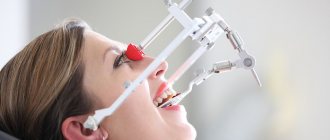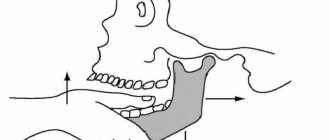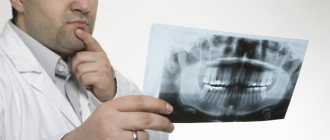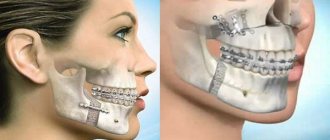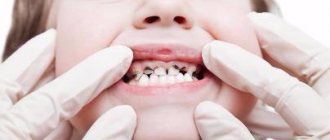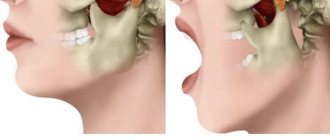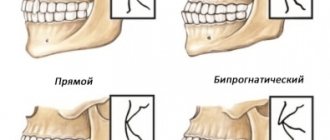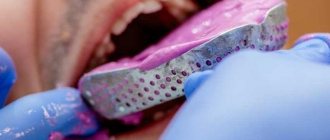Manifestations of distal bite in the mouth
Closing of lateral teeth during distal occlusion.
Distal occlusion is manifested in the mouth by the closure of the upper and lower teeth according to the “second class” (violation of the relationship between the projections of the antagonist teeth of the upper and lower jaw).
In the frontal segment (at the level of the front teeth) there are two closure options (the so-called first or second subclasses).
In the first case, a “sagittal gap” is observed, which reflects the discrepancy between the dentition in the sagittal plane (anterior-posterior direction). And the upper incisors are in protrusion (inclined forward). In the second option, the upper front teeth are tilted back (into retrusion). With the formation of a deep bite (when the lower teeth are not visible from under the upper ones).
Sagittal chain with distal occlusion. 2 class 1 subclass.
Distal occlusion. 2nd class 2nd subclass.
Causes of distal bite (distal occlusion)
They are almost always (in the vast majority of cases) skeletal...
- Posterior position of the lower jaw. This is the most common cause of distal occlusion
- Small (short) lower jaw.
Many people write that the cause of a distal bite may be an overdeveloped (excessively large) upper jaw. They say that this is why there is a “gap” between the front upper and lower teeth (sagittal gap)... Many years of observations and our experience have shown that this is not so. With any anomaly of occlusion, there can be no talk of any OVERdevelopment. Everything, on the contrary, is UNDERdeveloped.
The lower jaw ends up in a posterior position (the first reason) only because the lower teeth bump into the upper teeth while the upper jaw is shortened and narrowed (generally underdeveloped). Or, when the upper incisors are “wrapped” back, into retrusion (second subclass). In addition, with distal occlusion, the upper jaw is always narrower than the lower jaw. Which, by the way, is another reason for blocking the lower jaw in the posterior position. And this same “blocking” does not allow the lower jaw, which is caught in the trap, to develop normally. Here is the second reason for distal occlusion - underdevelopment of the lower jaw.
There is also a “dental” reason for distal occlusion. Or more precisely, the dental cause of closure is “second class”. This is when mesial (front) displacement of the upper lateral teeth occurs. And then, even with a normal relationship of the jaws in the sagittal plane, the closure of the lateral teeth (molars) will also be in the second class. True, this is not a true distal occlusion...
A “dental” cause of the second class may complement or may camouflage true distal occlusion. Therefore, it will not be possible to figure out what is the reason for the closure in class 2 visually (by eye). Diagnostics required.
Signs of a deep bite
Signs depend on the severity of the abnormality.
Mild degree
Often the patient does not notice the external manifestations of the pathology, because with a mild degree, the abnormal bite may not even distort facial features and speech. The main signs are small chips and microcracks of the upper front teeth.
Average degree
In addition to small cracks and chips, the following violations appear:
- increased abrasion of the enamel of the upper teeth on the inside;
- difficulties in pronouncing the sound “s”;
- the lower third of the face visually moves away, its height decreases;
- the act of biting is distorted, which leads to disruption of the entire chewing process;
- problems in the functioning of the temporomandibular joint (clicking, crunching and sometimes pain; it is difficult for the patient to open his mouth wide);
- the lips close unaesthetically - the lower or upper lips come forward strongly.
Severe degree
The most severe consequences of improper jaw development manifest themselves, namely:
- Violations of facial proportions.
Often such distortions are called a “bird” face, when the chin goes back strongly and the upper lip hangs excessively over the lower lip. The lower third of the face is also reduced.
- Trauma to the palate.
Due to the distal bite, the lower incisors reach the upper palate. Soft tissues are subject to mechanical friction not only during eating, but also at rest.
- Deformation of the upper jaw.
The upper teeth protrude forward, and the distribution of the load during chewing becomes completely uneven.
Diagnostics
The main goal of any diagnosis is to identify the cause of the problem. And make a diagnosis. Likewise, the diagnosis of distal occlusion is designed to identify the cause of closure in the second class. In order to separate the flies from the cutlets during treatment, so to speak. That is, dental causes of closure are in the second class from non-dental (maxillary, skeletal).
The main diagnostic methods are:
- Analysis of TRG (teleradiogram) of the skull in a lateral projection. It allows you to clearly determine all the skeletal (jaw) nuances of the problem. Both with the position of the jaws and with their sizes.
- Analysis of plaster models of jaws (for this, casts are taken). It allows you to clarify the “dental” nuances: the size of the teeth, the length and width of the dentition, the features of the relationship (including closure) of the upper and lower teeth
Analysis of TRG (teleradiogram) of the skull in a lateral projection.
Analysis of plaster models of jaws.
It is not recommended to fall below this diagnostic “bar”. Below - just by eye. But this, as we understand, is not the best option.
Diagnostics is the first and key step in the treatment of distal occlusion. Do you want to know why it’s impossible to do without diagnostics?
Errors in the treatment of distal occlusion
The first, main mistake is that many try to treat distal bite with one device. For example, only with braces (this is the most popular option). But braces, although a cool device, are not for skeletal problems. The level of hardware competence of the braces system does not extend further than “to place the teeth on the jaw.” And distal occlusion, as we have already said, is a purely skeletal problem. Jaws and posture are to blame. And braces are not capable of solving problems with posture or jaw problems. After all, braces cannot change the position or size of the jaw. No matter what the would-be doctors promise...
And therefore, such videos are just an advertising gimmick.
Or rather, a convenient “hook” that catches gullible patients. Convenient because it coincides with the desire to do everything quickly and efficiently... But it doesn’t coincide with reality.
And braces cannot be the main device in the treatment of distal occlusion.
Braces are the wrong choice when treating distal malocclusions. In any case, you definitely shouldn’t start with them. Braces, as mentioned and shown above, can be effectively used only at the final stage of treatment of distal occlusion. All major “feats” must be accomplished before working on the teeth. Before using braces. And they are accomplished at the level of the jaws and skeleton (posture). Otherwise, there will simply be nothing to “clog” (close) these teeth (read with braces). See “Fundamentals of the therapeutic concept of “Ortho-Arteli”.
The second common mistake in correcting distal occlusion is treatment with the removal of upper premolars (4 or 5 teeth).
And this mistake is much more serious. Because it can have the most dire consequences. See "Orthodontic treatment with tooth extraction."
After all, as we said above, the main causes of distal occlusion are skeletal. And most often the lower jaw is to blame. And if so, then a reasonable question arises: if the lower jaw is to blame, what does the upper teeth have to do with it (their removal). Where is the logic?
In general, all errors in the treatment of distal occlusion in an adult are usually associated with insufficient diagnosis. Which entails a misunderstanding of the reasons for the occurrence of distal occlusion in each specific case.
For example, the “dental” cause of distal occlusion is very often confused with the “skeletal” (jaw) cause. We remind you that in the first case you need to move the lateral teeth back. And in the second - to push the lower jaw forward and develop the upper one. And if you get confused, if you don’t figure it out... Start distalizing the upper teeth, or worse, remove them when it is necessary to advance the lower jaw... Or vice versa. It is clear that nothing good will come of it.
The third mistake is when, without understanding what’s what, what exactly is the cause of distal occlusion, but realizing, however, that the problem cannot be corrected with braces, they try to solve the problem surgically. Using orthognathic surgery. Through osteotomy of the lower and upper jaws.
This is where I would like to dwell in more detail. And explain something. Why do orthodontists send to a surgeon to “treat” a distal bite? They have already said: they understand that braces will not cope. But they don’t understand how to treat it without braces. They don’t understand because in dentistry in general, and orthodontics in particular, there are a lot of prejudices regarding the possibilities of moving the lower jaw forward and developing the upper jaw. And these, as we saw above, are the main (“key”) points in the treatment of distal occlusion.
Most orthodontists simply do not believe in this (that it is possible in principle). Because someone (even a “great one”) said two hundred years ago that this cannot be done. Time has passed. Everyone has already forgotten why it is “impossible”. But no one even bothered to check why, in fact, it was impossible...
And therefore, those doctors who blindly believe in these moss-covered “dogmas” simply do not see an alternative. And for them there are only two extreme poles in the treatment of distal occlusion: braces and surgery. That's all.
During a direct examination by a specialist, you will be able to find out your exact diagnosis, as well as receive a referral for diagnosis or a treatment plan.
And in our clinic we treat distal occlusion between these two poles. Using methods of maxillofacial orthopedics and craniodontics. Here are the ones: changing the position of the lower jaw and changing the size of the upper. And we get good results, without regard to the fact that someone once said something... We must always double-check what was said. We checked. And everything turned out to be somewhat different. Or rather, not at all the way they “frightened” us. You can also push it out. It can be developed. You just need to know how, because there are some “secrets” here. And we, at the Orto-Artel clinic, knowing these “secrets”, take advantage of these opportunities, successfully eliminating distal occlusion of any complexity.
By the way, if we are talking about surgical treatment of distal occlusion, then we need to determine when and in what cases surgery is generally appropriate. But the indication is basically the same - a small lower jaw, the so-called lower micrognathia, and the micrognathia is very pronounced.
We indicated this reason above as one of the skeletal reasons. I will add: the lower jaw should be VERY short. Literally ugly. Only then can this be resolved surgically. In all other cases, you can do without surgery. Proven and tested many times.
By the way... In our clinic, a good half of the patients have formal indications for surgical treatment of distal occlusion. But only a few got to the surgeon. Because formalities are formalities, but compromise solutions were found that satisfied everyone: both the patients and us. This is because we approach treatment not formally, but in essence. And we are guided by logic and common sense.
Well, as a special case of a short lower jaw, which cannot be corrected except by surgery, this is a small chin. If it is small and spoils the face, then even by pushing the lower jaw forward we will not get the aesthetics we want. Simply because orthodontists do not have the means and instruments (devices) to selectively influence the chin. It is impossible to stimulate the chin to grow. Only surgery.
Inferior micrognathia.
This is where the indications (and there is essentially one) for surgical intervention for distal occlusion end.
Going with a knife into the upper jaw - God forbid! Even if the upper jaw is indirectly to blame for the distal occlusion. More precisely, the upper jaw also, as a rule, suffers (dimensionally) with distal occlusion. The upper jaw is directly connected to the base of the skull. And such interventions can then backfire. Literally. And the most important thing is that there is no need to go there surgically. The upper jaw can be developed!!!
Malocclusion in a child: identify and correct it in time!
Normal or pathological bite?
If the teeth in the lateral section close so that each upper tooth falls between the two lower ones (this position of the teeth is also compared to a caterpillar tractor), and the upper front teeth overlap the lower ones by one third, then such a bite can be called normal, even standard.
And doctors call it orthognathic. Variants of the norm also include the correct closure of the lateral surfaces, but at the same time a slight rotation or rotation of one of the teeth, as well as small gaps (diastemas) between the teeth. Also within normal limits, there may be slight crowding of the teeth in the lower jaw.
Now let's talk about bite pathologies... These include distal bite, when the upper jaw is strongly pushed forward relative to the lower jaw. Such a bite may be associated with underdevelopment of the lower jaw with a normally developed upper jaw or, conversely, with an overdeveloped upper jaw against the background of normal development of the lower jaw. A similar bite pathology can occur due to congenital (hereditary) underdevelopment of the jaws, as well as due to impaired nasal breathing or due to a number of pathologies of other body systems. For example, due to difficulty in nasal breathing, a child has to breathe through his mouth, as a result of which the cheek muscles are in a tense state, which prevents the development of the lower jaw. Also, the formation of a pathological distal bite is promoted by throwing back the child’s head during sleep. Recession of the lower jaw in this position of the head leads to its underdevelopment. The problem of distal occlusion arises and is identified in childhood, when the formation and growth of the body as a whole occurs.
Mesial bite is most often the result of a skeletal abnormality, that is, a problem in the structure of the lower jaw. This is mainly a hereditary form of malocclusion. Since the lower jaw is overdeveloped, it is pushed forward in relation to the upper. Those with this type of bite are characterized by a large, so-called archaic chin. This malocclusion pathology is most often treated surgically: a resection (removal of part) of the jaw is performed, and only then the position of the teeth is corrected with the help of braces.
Another type of bite pathology is an open bite, when the teeth in the lateral regions close together, but not in the front. This type of bite develops as a result of bad habits - prolonged nipple sucking (up to 4-5, and sometimes 6 years), thumb sucking, and also in children who chew pencils. You may ask, where do bad habits in children come from? Let's figure it out. As we know, breastfeeding is of great importance in the formation of the bite. A child is born with a distal bite, when the lower jaw is slightly behind, and this is the norm for a newborn. It is this position of the jaws that allows the baby to simultaneously swallow milk and breathe. When a baby suckles at the breast, he is forced to make certain muscular efforts and move his jaw forward. This stimulates the growth and development of the lower jaw. If breastfeeding is not available, the baby is bottle-fed. Often, mothers make too large holes in the nipple in order to “facilitate” the sucking process for the baby, and the milk actually pours into the mouth itself - the baby no longer needs to make any effort during the sucking process. The result is that the lower jaw does not develop. When the baby switches to regular food, he compensates for the sucking stage by sucking fingers, pacifiers, etc. The second important factor in the formation of bad habits is difficult nasal breathing, in which the child is forced to constantly keep his mouth open. Try sitting for a long time with your mouth open. Even for an adult whose facial muscles are well developed, this is quite difficult. Trying to alleviate the situation, the child puts a finger or a pencil in his mouth so that the muscles relax. After all, “leaning” on a pencil, he can calmly breathe through his mouth for a long time.
Therefore, parents should understand how important it is to avoid the formation of bad habits: they need to choose orthodontic nipples with the required number and diameter of holes (they can be bought at almost any large pharmacy) and “force” the baby to suck correctly, as well as resolve problems that impede the child’s free nasal breathing depending on the reasons creating these problems. Believe me, the formation of a child’s correct bite largely depends on the mother.
However, if the baby has already become the owner of one or more bad habits, then this can be treated quite successfully: at the age of 5–6 years, the nipples are replaced with special plates with flaps and grilles for the tongue, which allow you to quickly correct an open bite.
In a deep bite, the upper jaw overlaps too much with the lower jaw. The reasons for the development of a deep bite are mainly underdevelopment of the lower jaw, skeletal forms of anomaly, or such a bite can be caused by a certain position of the teeth. This bite is considered traumatic, since when chewing, the lower incisors hit the upper palate. As a result, traumatic gingivitis develops.
Crossbite is another type of pathological bite that occurs mainly in the lateral parts of the jaw. Outwardly, it looks like a shift of the chin to one side or the other. Crossbite can develop as a result of jaw injury, underdevelopment of the lateral parts of the lower jaw, as well as a bad habit - when a child sleeps or sits with his cheek propped up with his fist (at the age of 5–6 years). Moreover, in an adult, such a bad habit has no effect on an already formed bite.
Meeting an orthodontist
It is necessary to visit a pediatric orthodontist for the first time at the age of 3.5–4 years, when preparations are underway for the formation of a permanent bite. At this age, distal and medial bites can be diagnosed. If necessary, treatment will be prescribed: wearing plates or caps. At the same time, you cannot yet determine a deep bite, since it is the norm during this period.
The rudiments of permanent teeth begin to form while the baby is in the womb, and this process continues in the first years of life. The baby teeth are close to each other, but at the age of 3.5 years, as the jaws grow, gaps between the teeth (diastema) begin to appear, and by the age of 6 they can reach the distance of one baby tooth. This is due to the fact that the buds of permanent teeth and the permanent teeth themselves are larger than milk teeth. Therefore, this is a normal process that should not cause any concern to parents.
In addition, parents are often frightened by the “disproportionately” large erupted permanent incisors. However, this is normal, because the jaw will grow, and over time, the once “too large” teeth will become absolutely normal, that is, proportional to the size of the jaws.
If the doctor does not reveal any violations, then the next visit should take place at 6–7 years of age - during the period of replacement of milk teeth with permanent ones. First, the “sixes” erupt (by the way, there are no 6 primary teeth) and the incisors are replaced. At this age, it will be clear whether there is enough space for all the other teeth. If not, then at this stage you should begin orthodontic treatment - wearing mouth guards or plates. The purpose of the plates in this case is to stimulate jaw growth and straighten teeth. Mouth guards are designed to correct the bite, widen the jaw, and eliminate bad habits.
If at the age of 6–7 years no malocclusion was detected, then the next visit to the orthodontist is necessary at 10 years. At this age, the distant – 4th and 5th – chewing teeth, as well as canines, begin to change. And it is the fangs that may not have enough space in the row. This problem can be solved by using plates or partial braces on the front four teeth.
It is also necessary to be observed by an orthodontist during the period of eruption of “eights” (the so-called wisdom teeth) - at about 16-17 years old, but now there is a tendency towards earlier eruption of 8 teeth (at 15 years). They can greatly affect your bite. If there is not enough space for the insidious “eights” to erupt, this can lead to crowding of teeth, often to an even greater extent than before. And then wearing braces cannot be avoided. In cases where wisdom teeth have not erupted, it is necessary to take an x-ray, which will help determine how much their rudiments will affect the bite. If there is not enough space in the jaw and the “eights” begin to put pressure on the 7th teeth, then all four rudiments of the 8th teeth will most likely have to be removed. And such removals have a fairly high percentage - approximately 80 out of 100 cases, especially if the teeth are large.
Bite correction
To correct the bite in childhood, plates and mouth guards are mainly used - that is, removable structures. From 6 to 12 years of age, if necessary, children wear plates that, by putting pressure on the growth zones, stimulate the jaws and allow them to develop correctly. Of course, it is not necessary to wear the plates all the time: for example, after 1–1.5 years of correction, a break is taken (and at the time of changing teeth, they are removed without fail). As the jaws grow, the plates change. And the sooner we begin to correct the bite, the shorter the periods of wearing the plates and the faster the desired result is achieved.
Since the plates are removable structures, it is very important that the child does not forget to put them on. And if the baby does not want or forgets to wear the plates, then the responsibility for following medical recommendations falls on the parents. You need to wear the plates at least 12 hours a day, maximum 16, mostly at night and several hours during the day, and remove them while eating and playing sports. Actually, the longer the child wears the plate during the day, the faster the correction process occurs.
As practice shows, if a child tolerates the plates well, then at a later age he no longer returns to the orthodontist and avoids longer bite correction with the help of braces and the subsequent long-term (and sometimes lifelong) wearing of retainers (retaining arches, caps). , records).
If we are talking about bite correction at 12–14 years old, then braces are used. At this age, the period of wearing braces depends on the pathology of the bite and its severity. However, in adolescents, correction usually occurs faster: it is enough to wear braces for a year (in adults – 1.5–2 years). During the retention (or holding) period at this age, an arch is not placed, as in adults, but removable structures are used - plates or mouthguards (it is easier to maintain hygiene with them), which must be worn at night. On average, after 2 years, the retention period ends (in adults it takes 2 years or more).
Contraindications for orthodontic treatment
Orthodontic treatment for children with mental illness, organic diseases of the central nervous system (for example, with cerebral palsy), oncology and any other serious diseases of any organs and systems of the body is not carried out.
Relative contraindications may include periodontitis and grade 2–3 tooth mobility. And, of course, in pediatric orthodontics we often have to deal with the problem of poor oral hygiene. Moreover, if with children, say, up to 12–13 years old, parents cope and are able to control the timely brushing of their teeth, then with teenagers this situation most often gets out of control. If a teenager does not take care of his hygiene, then wearing, for example, braces leads to the rapid development of caries. In these cases, we advise you to “outgrow” a difficult age - after all, you can start correcting your bite at any time when a person has motivation and responsibility.
